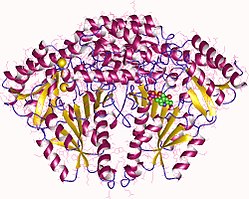Aromatic L-amino acid decarboxylase
| Aromatic L-amino acid decarboxylase | ||
|---|---|---|

|
||
| dimer, human | ||
| Properties of human protein | ||
| Mass / length primary structure | 338 to 480 amino acids (depending on isoform) | |
| Secondary to quaternary structure | Homodimer | |
| Cofactor | Pyridoxal phosphate | |
| Isoforms | 4th | |
| Identifier | ||
| Gene names | DDC AADC | |
| External IDs | ||
| Enzyme classification | ||
| EC, category | 4.1.1.28 , lyase | |
| Response type | Decarboxylation | |
| Substrate | DOPA, L-5-hydroxy-Trp, L-Trp | |
| Products | Dopamine, Serotonin, Tryptamine + CO 2 | |
| Occurrence | ||
| Homology family | AADC | |
| Parent taxon | Chordates | |
| Orthologue | ||
| human | House mouse | |
| Entrez | 1644 | 13195 |
| Ensemble | ENSG00000132437 | ENSMUSG00000020182 |
| UniProt | P20711 | O88533 |
| Refseq (mRNA) | NM_000790 | NM_001190448 |
| Refseq (protein) | NP_000781 | NP_001177377 |
| Gene locus | Chr 7: 50.46 - 50.57 Mb | Chr 11: 11.81 - 11.9 Mb |
| PubMed search | 1644 |
13195
|
Aromatic L-amino acid decarboxylase (AADC) , also called DOPA decarboxylase (DDC) , is the name for enzymes in chordates that catalyze the biosynthesis of dopamine , serotonin and tryptamine by means of decarboxylation . The German pharmacologist Peter Holtz is considered to be the discoverer .
Mutations in the corresponding DDC - gene and subsequent lack of enzyme lead to lack of the appropriate neurotransmitters and catecholamines . AADC is a gene therapeutic target for the treatment of Parkinson's disease ; Phase I studies were successfully completed in 2008. Some patients with polyendocrine autoimmune disease type I (APS1) show autoantibodies to AADC. Some variants of the AADC are associated with nicotine addiction .
Catalyzed reactions
L-DOPA is decarboxylated to dopamine (catecholamine synthesis).
5-hydroxy-L-tryptophan is decarboxylated to serotonin .
L-tryptophan is decarboxylated to tryptamine .
L-histidine is decarboxylated to histamine .
L-tyrosine is decarboxylated to tyramine (tyrosine breakdown).
L-phenylalanine is decarboxylated to phenethylamine (L-Phe degradation).
More functions
Although ubiquitous in the body, a study with mice showed particularly high concentrations of AADC in the kidneys and intestines, and observed differences in kidney concentrations between males and females could be responsible for corresponding sex differences in the sodium balance. It is important for the development of taste buds in mice.
AADC plays a role in the androgen receptor signaling pathway .
Individual evidence
- ↑ UniProt P20711
- ↑ Eberling JL, Jagust WJ, Christine CW, et al : Results from a phase I safety trial of hAADC gene therapy for Parkinson disease . In: Neurology . 70, No. 21, May 2008, pp. 1980-3. doi : 10.1212 / 01.wnl.0000312381.29287.ff . PMID 18401019 .
- ^ Mochizuki H, Yasuda T, Mouradian MM: Advances in gene therapy for movement disorders . In: Neurotherapeutics . 5, No. 2, April 2008, pp. 260-9. doi : 10.1016 / j.nurt.2008.01.005 . PMID 18394568 .
- ↑ Candeloro P, Voltattorni CB, Perniola R, et al : Mapping of human autoantibody epitopes on aromatic L-amino acid decarboxylase . In: J. Clin. Endocrinol. Metab. . 92, No. 3, March 2007, pp. 1096-105. doi : 10.1210 / jc.2006-2319 . PMID 17200166 .
- ↑ Yu Y, Panhuysen C, Kranzler HR, et al : Intronic variants in the dopa decarboxylase (DDC) gene are associated with smoking behavior in European-Americans and African-Americans . In: Hum. Mol. Genet. . 15, No. 14, July 2006, pp. 2192-9. doi : 10.1093 / hmg / ddl144 . PMID 16740595 .
- ↑ López-Contreras AJ, Galindo JD, López-García C, Castells MT, Cremades A, Peñafiel R: Opposite sexual dimorphism of 3,4-dihydroxyphenylalanine decarboxylase in the kidney and small intestine of mice . In: J. Endocrinol. . 196, No. 3, March 2008, pp. 615-24. doi : 10.1677 / JOE-07-0564 . PMID 18310457 .
- ↑ Seta Y, Kataoka S, Toyono T, Toyoshima K: Immunohistochemical localization of aromatic L-amino acid decarboxylase in mouse taste buds and developing taste papillae . In: Histochem. Cell Biol . 127, No. 4, April 2007, pp. 415-22. doi : 10.1007 / s00418-006-0257-3 . PMID 17211625 .
- ↑ Margiotti K, Wafa LA, Cheng H, Novelli G, Nelson CC, Rennie PS: Androgen-regulated genes differentially modulated by the androgen receptor coactivator L-dopa decarboxylase in human prostate cancer cells . In: Mol. Cancer . 6, 2007, p. 38. doi : 10.1186 / 1476-4598-6-38 . PMID 17553164 . PMC 1904238 (free full text).










